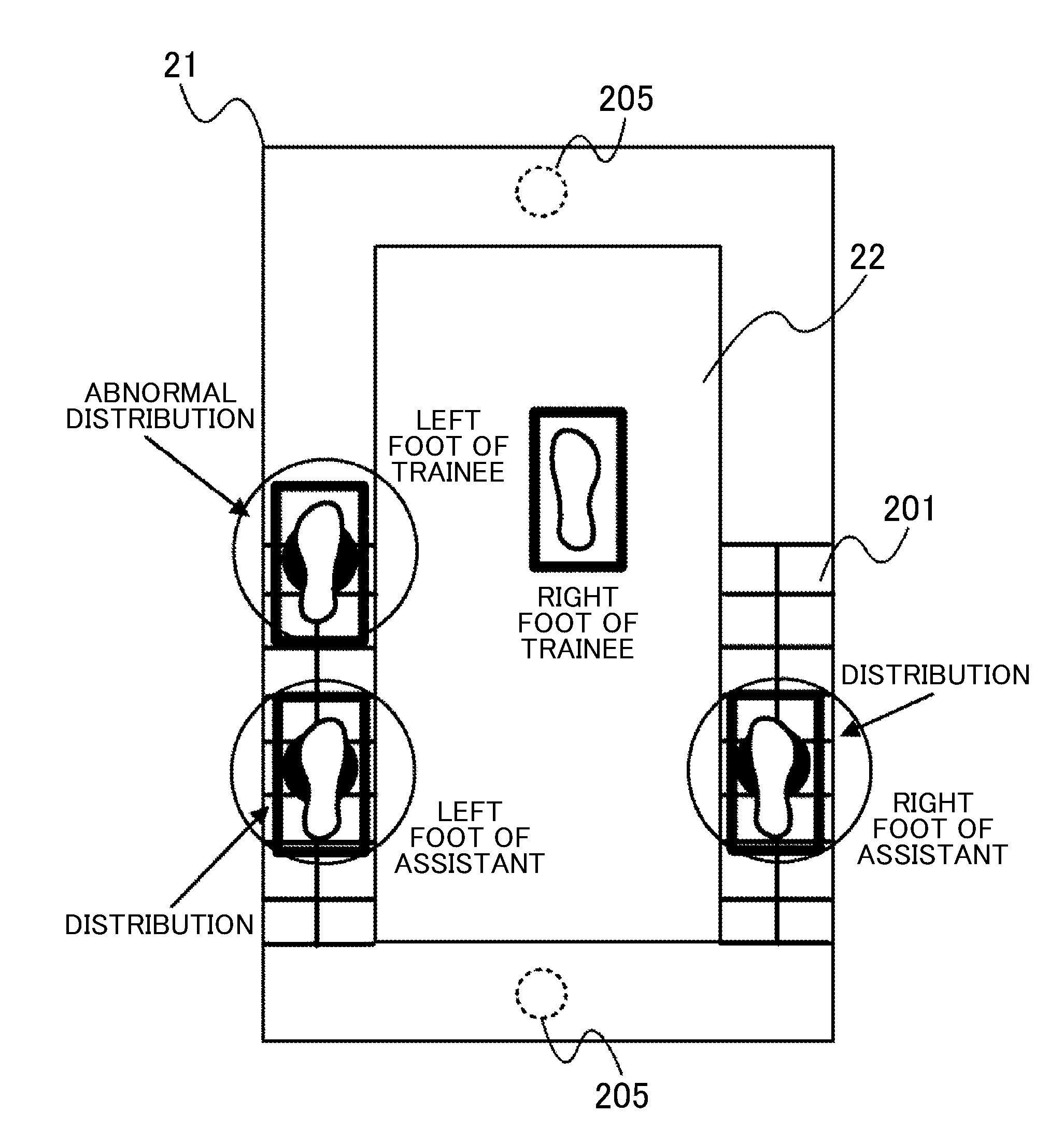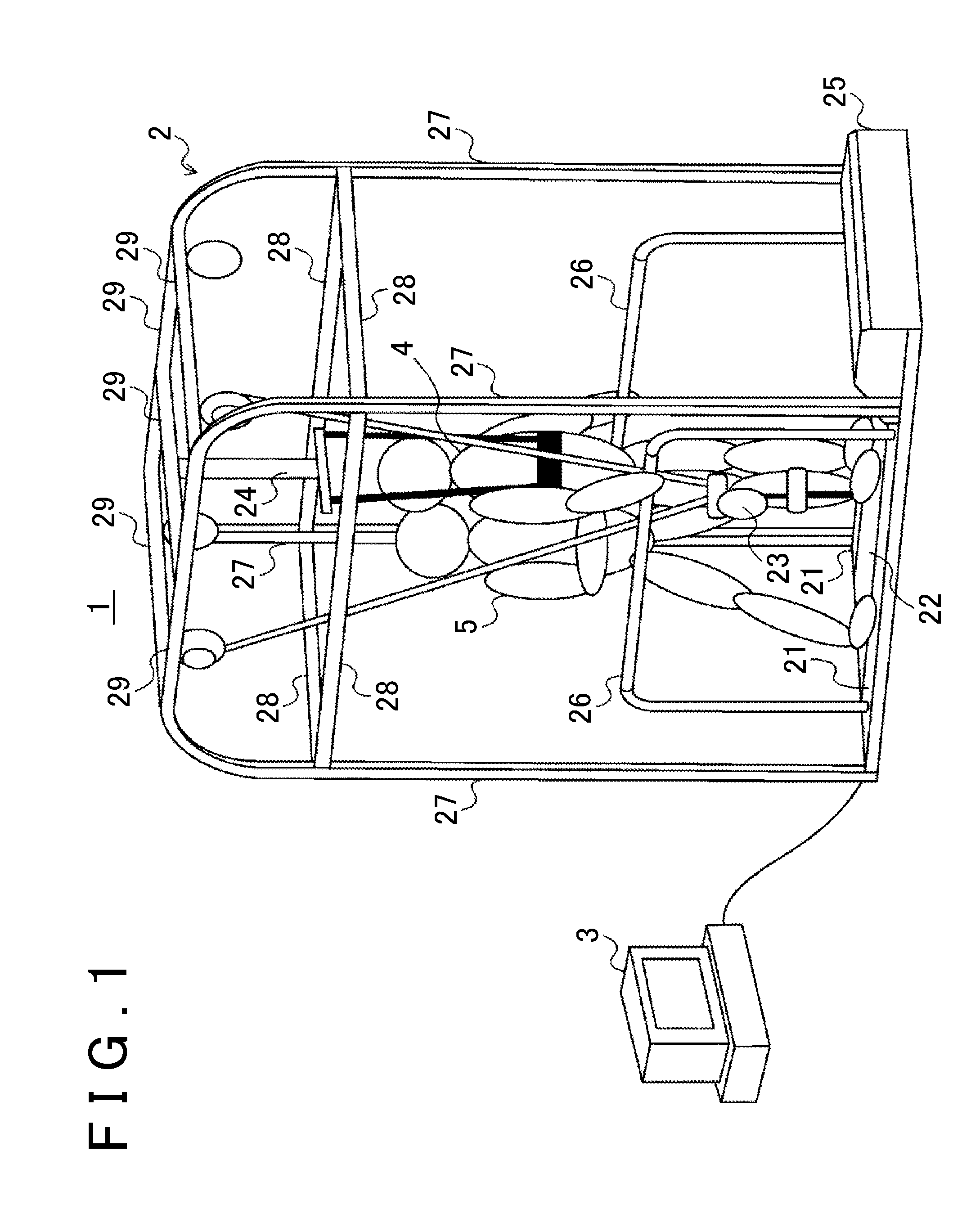Walking training system
a training system and walking technology, applied in walking aids, physical therapy, chiropractic devices, etc., can solve the problems of device not being able to detect abnormal states
- Summary
- Abstract
- Description
- Claims
- Application Information
AI Technical Summary
Benefits of technology
Problems solved by technology
Method used
Image
Examples
first embodiment
of the Present Invention
[0054]A first embodiment is described. First, the configuration of a walking training system 1 in the first embodiment is described below with reference to FIG. 1. As shown in FIG. 1, the walking training system 1 includes a treadmill 2 and a control device 3.
[0055]The treadmill 2 is a device on which a trainee 4 conducts walking training. The treadmill 2 functions as a walking training device. The control device 3 is a device that controls the treadmill 2. The control device 3 is typically a Personal Computer (PC). However, the control device 3 is not limited to a personal computer, but other information processing devices, such as a tablet terminal or a smartphone, may also be used.
[0056]The treadmill 2 includes a frame 21, a belt conveyor 22, a robot 23, a relief device 24, a motor box 25, a pair of handrails 26, a plurality of vertical frame components 27, and a plurality of upper frame components 28 and 29.
[0057]The frame 21 is a part on which an assista...
second embodiment
of the Present Invention
[0110]Next, a second embodiment is described. In the description below, the same contents as those in the first embodiment are omitted as necessary. In the first embodiment, an example is described in which the load sensors 201 are arranged closely to each other in a grid pattern in all the range of the frame 21. However, because the assistant 5 supports the trainee 4 behind the trainee 4 with both hands, the range of the frame 21, in which the assistant 5 places the feet, is limited to a predetermined range on the backward side. In addition, because the trainee 4 is supported by the assistant 5 with both hands, the trainee 4 is positioned very near to the assistant 5. Therefore, when the trainee 4 loses balance and places his or her foot onto the frame 21, the foot of the trainee 4 is very likely to be positioned near to the foot of the assistant 5.
[0111]That is, in the first embodiment, when two load distributions are detected, it is determined whether thos...
third embodiment
of the Present Invention
[0124]Next, a third embodiment is described. In the description below, the same contents as those in the first embodiment are omitted as necessary. In the first embodiment, it is determined that an abnormal state is detected if there are three or more feet on the frame 21. However, when the assistant 5 loses balance and steps into the belt conveyor 22, it becomes difficult for the assistant 5 to support the trainee 4 and for the trainee 4 to continue walking training. In the third embodiment, a walking training system 1 that can detect such a condition as an abnormal state is described.
[0125]The third embodiment is different from the first embodiment in that the plurality of load sensors 201 are arranged, not on the frame 21, but on the belt conveyor 22. The load sensors 201 are arranged below the upper belt of the belt conveyor 22. This allows a load to be detected also on the belt that moves. The plurality of load sensors 201 are arranged in a grid pattern ...
PUM
 Login to View More
Login to View More Abstract
Description
Claims
Application Information
 Login to View More
Login to View More - R&D
- Intellectual Property
- Life Sciences
- Materials
- Tech Scout
- Unparalleled Data Quality
- Higher Quality Content
- 60% Fewer Hallucinations
Browse by: Latest US Patents, China's latest patents, Technical Efficacy Thesaurus, Application Domain, Technology Topic, Popular Technical Reports.
© 2025 PatSnap. All rights reserved.Legal|Privacy policy|Modern Slavery Act Transparency Statement|Sitemap|About US| Contact US: help@patsnap.com



